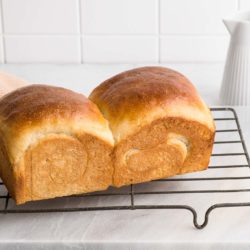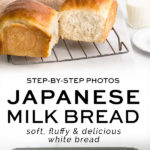Japanese Milk Bread (Shokupan)

- Resting Time: 2 hours
- Prep Time: 30 mins
- Cook Time: 30 mins
- Total Time: 1 hour
- Yield: 1 loaf
- Category: Bread
- Method: Oven
- Cuisine: Japanese
Japanese Milk Bread is soft, fluffy and pillowy, making it the perfect loaf of sliced white bread! Make your own delicious Japanese Milk Bread with this easy recipe with step-by-step photos.
Ingredients
For the Tangzhong
- 2 tablespoons strong white bread flour
- 100 ml (1/3 cup plus 1 tablespoon) milk
For the Japanese Milk Bread Dough
- 350 g (2 1/3 cups) strong white bread flour
- 3 g (1 teaspoon) instant dried yeast
- 1 teaspoon fine salt
- 55 g (1/4 cup) caster sugar
- 1 egg
- 125 ml (1/2 cup) milk, warmed to 37°C/98°F
- 50 g (1/2 stick) unsalted butter, softened
For the Eggwash
- 1 egg
- 1 tablespoon milk
Instructions
For the Tangzhong
- Whisk the ingredients together in a small saucepan.
- Place the saucepan over low heat.
- Keep whisking until the ingredients form a thick paste. The consistency should be thick enough so that as you whisk the mixture, the whisk leaves lines in the mixture which remains.
- Remove the paste to a small bowl, and set it aside to cool down.
To Make the Dough
- Measure the flour, yeast, salt and sugar into the bowl of an electric stand mixer.
- Mix the dry ingredients together using a dough hook.
- Add the egg and the cooled Tangzhong.
- Slowly add the milk until the mixture comes together into a sticky dough.
- Add the butter, one tablespoon at a time. Wait for each tablespoon of butter to be fully incorporated into the dough before adding the next.
- Continue kneading the dough on medium speed for about 10-15 minutes, or until the dough passes the windowpane test. (See Kitchen Notes below). By this stage, the dough should also be coming away from the sides of the bowl.
- Lightly oil a large, clean mixing bowl.
- Roll the dough into a smooth ball and place it into the mixing bowl.
- Cover the dough with a clean tea towel or bowl cover, and place it somewhere warm for about 1.5 hours, or until it has doubled in size.
Portion the Dough
- Gently remove the dough from the bowl. The dough will deflate as you handle it.
- Divide the dough into two equal portions.
- Roll each portion of dough into smooth balls, and set them aside on the kitchen bench for about 20 minutes to puff up slightly. Cover them with a clean tea towel during this time.
Shaping the Dough
- Take one of the balls of dough and roll it out until it is about 15 cm x 20 cm.
- Make an envelope fold, i.e. fold the right end towards the centre, then the left end towards the centre.
- With the short side of the dough facing you, roll the dough tightly and away from you.
- Place the rolled-up dough into the end a loaf pan with the seam facing the centre.
- Repeat the above steps with the second piece of dough.
Proving the Shaped Dough
- Place the loaf pan somewhere warm, covered with a clean tea towel, for about 30-45 minutes, or until the dough has risen to about the same height as the loaf pan.
Baking the Japanese Milk Bread
- Preheat the oven to 180°C/356°F.
- Place a metal baking tray on the lower to middle shelf.
- Lightly brush the bread dough with some egg wash.
- Bake the bread for about 25-30 minutes, or until it is lightly golden. The bread is cooked if an internal thermometer reads 85°C/185°F.
- Leave the bread in the pan for about 5 minutes, before removing the bread to a wire rack to cool completely.
Kitchen Notes
 WINDOWPANE TEST
WINDOWPANE TEST
Pinch off a small piece of dough, roll it into a ball and use your hands to gently stretch the dough. If the dough can stretch to form a thin sheet and be almost translucent so that you can see the light through it, your dough has passed the “windowpane test”. This means that you have kneaded the dough sufficiently and that the dough is ready to be proofed.
 LOAF PAN DIMENSIONS
LOAF PAN DIMENSIONS
The loaf pan I have used for this recipe measures 20 x 10 x 9 cm. If you are using a longer loaf pan, I recommend cutting the dough into 3 or 4 portions.
 DIFFERENT TYPES OF FLOUR
DIFFERENT TYPES OF FLOUR
* For Swiss readers: I use Zopfmehl (or farine pour tresse) when making bread and enriched dough.
 DIFFERENT TYPES OF YEAST
DIFFERENT TYPES OF YEAST
* Please note that there is a difference between instant yeast (also called instant dried yeast or fast-action dried yeast) and dried yeast (also called active dry yeast). If you are not sure what type of yeast you have, please check the packaging for instructions on how to use the yeast.
* With instant yeast, you can add it directly to the flour mixture without having to activate it first.
* With dried yeast, you will need to activate it first (usually in some warm liquid).
 PROOFING THE DOUGH
PROOFING THE DOUGH
Dough needs a warm environment for the yeast to activate and cause the dough to rise. If you don’t have a warm place in your home, try one of the following ideas:
* In the oven with the oven light switched on (works only for some ovens).
* In the oven with a tray of boiling water on the bottom shelf.
* In the oven at a low temperature of about 25-30°C (77-86°F).
 OVEN TEMPERATURES
OVEN TEMPERATURES
All recipes on this website state temperatures for a regular oven (i.e. a conventional oven without fan). If you have a convection oven with a fan, please consult the manufacturer’s handbook on how to adjust the temperature and baking time accordingly.
 CONVERSIONS
CONVERSIONS
To convert from cups to grams, and vice-versa, please see this handy Conversion Chart for Basic Ingredients.
View the recipe online: https://eatlittlebird.com/japanese-milk-bread-shokupan/


